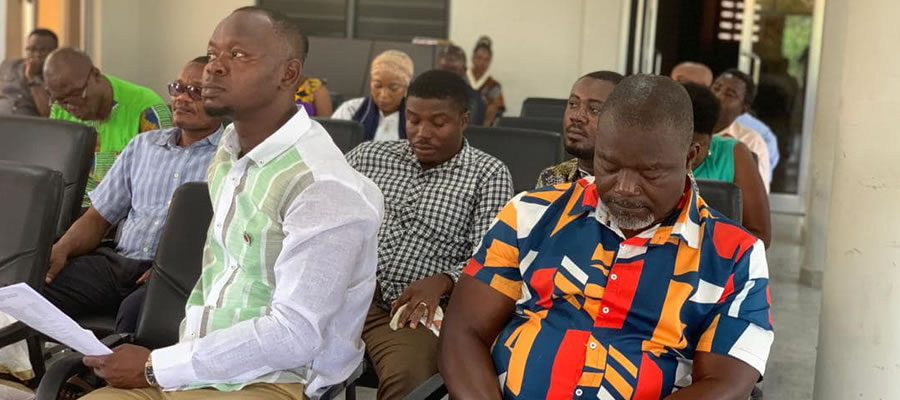

There is an extensive tarred road network linking all the zonal centres in the district. A greater part of which is in good motorable state. However, roads from the zonal centres to the outlying settlements are limited. On the whole, the road network in the district is comparatively better than most of the neighbouring districts.
About 70% of the total road network is tarred, while the remaining 30% is laterite. On the whole, 95% of the total road network is motorable all year round. However, in the last five years and as is indicated in the first medium term plan; only the Ninta to Ofoase road was constructed wide (Table 9 in pdf file below). The other road works, which are mainly rehabilitation and gravelling, were unattended to due to lack of funds, further depriving the district of a viable potential for rapid development.
Agona Swedru is the only town officially enjoying telephone facilities. Nsaba has a telephone facility but it is on the Winneba Exchange. Seven communities, including the district capital, are served by post offices and another four are served by postal agencies. All the big towns, with the exception of Nkum, are linked to the national grid. About 95% of all the settlements in the district have access to potable water.The district has the most developed rural water system in the country.
Both public and private schools are available at the nursery, primary and JSS levels, and there are five public senior secondary schools as well. The public health service comprises a district hospital in the capital, one health post and four community health posts. There are also 16 private owned clinics and maternity homes and three owned run by missions.
Water
The district is adequately served by an elaborate water supply system from the Kwanyako-Headworks. This is supplemented by hand-dug wells, boreholes, streams etc. etc. making potable water available to about 73% of the district’s population. However, pollution and siltation of major rivers which sustain the potable water network are major problems.
Electricity & Energy Supply
The major sources of energy for both domestic and industrial purposes are fuelwood, charcoal, kerosene and electricity. There is however a heavy dependence on traditional energy sources for cooking/ heating and kerosene for lighting. Seven outof eleven zonal centres are connected to the national electricity grid. However, power supply to the outlying settlements is insignificant and out of a total of 862 settlements only fifteen (15) have electricity supply.
This state of affairs has been dictated by socio-economic factors prominent among which is poverty.The resultant over-dependence on the traditional sources of energy poses a serious threat .to the forest and tree stock in the district. Already, the activities of chainsaw operators and timber merchants have had a tremendous negative impact on the forest vegetation.
Transport & Telecommunications
The contribution of the private sector to road transport and communication cannot be over emphasized.The large volume of trade and other economic activities in the district have been made possible through the enormous contribution of the private sector. The efficient road transport system of the district is dominated by this sector and movement to and from the district is possible at least twenty (20) hours a day. Unfortunately, telecommunication facilities are not as well developed as transport. Most of the zonal centres can boast of only postal services and the much-needed extension of telephone facilities from the district capital to these areas has been hampered by lack of funding.
Banking
The district is serviced by a number of banking institutions. Notable among these are the Ghana Commercial Bank, Agriculture Development Bank, Co-operative Bank and a number of Rural/Community Banks.
Employment
The Agona District has a large pool of unemployed labour. This supply (which is mostly unskilled) is cheap and available to potential investors who might consider setting up business in the district. There is also a reasonable supply of semi-skilled labour made up of J.S.S. and S.S.S. graduates who could not further their education for one reason or the other. Besides the large number of artisans and craftsmen such as carpenters, auto- mechanics, masons etc. etc. cannot realize their full potential due to the non- availability, of opportunities.
Trade and Commerce
The most dominant market centres of the district are Swedru and Nsuansa markets. These alone account for about 70% of the volume of trade in the district. Swedru in particular happens to be the commercial centre of-the entire region. However, the general marketing infrastructure to support the enormous wholesale and retail trading activities are extremely inadequate.
Farming
Agriculture happens to be a major source of livelihood in the district.It engages at least 62% of the entire population. The major food crops cultivated are cassava, maize, plantain, yam.etc.Cocoa, coconut, sugar cane, oil palm etc. etc. also constitute the main cash crops cultivated. Whilst the district has consistently produced food items in excess of demand, cash crop production (esp. cocoa) has also increased as a result of increases in-the producer price of the crop. Nonetheless, the lack of readily available credit facilities has tended to dampen the spirit of a good number of farmers. Farming methods are also still primitive and involve use of the cutlass and hoe.
Livestock and Fisheries
The commercial production of livestock and fisheries is on a very limited scale. These include cattle, goats, sheep, poultry and pigs. Apart from isolated instances of medium scale poultry and cattle production located, in the outskirts of the larger settlements, most animal rearing activities are for domestic consumption.
Health
The Agona West Municipal experiences a low level of service delivery. The achievement of health for all by the year 20QO" under Ghana’s Vision 2020 and the willingness of the people to avail themselves of medical attention in times of need is persistently undermined by the frustrations and inadequacies of the health delivery system. The district boasts of twenty-four (24) health institutions of sorts. The best one among these happens to be a government hospital.
However, this hospital itself is plagued by a host of problems including lack of adequate-functioning modern equipment, skilled medical personnel, accommodation etc. Participation of the private sector is therefore very important and accounts.-for about 62% service delivery. These are however mainly clinics, maternity homes, traditional birth attendants etc. etc.The doctor-patient ratio is about 1:31889; a situation which gives room for serious concern.
The distribution of health facilities in the district is also skewed in favour of the urban centres especially Agona Swedru the district capital. As a matter of fact, all the three- (3) hospitals of the district are located in Agona Swedru. This creates a situation where the only government hospital is unable to cope with the volume of referrals, coming from the hinterland.
Education
The Assembly boasts of 46 Kindergartens, 117 Primary Schools, 73 J.S.S. Schools and 5 S-enior Secondary Schools. There is no Vocational/Technical or Training College. Out of a .total enrolment of about 35,000 pupil’s and Students. 55% are males and 45% females. Only 40% of children of school going age find, id their way to school. There is a teacher-pupil ratio of 1:34 and 86% of the teachers are professionals. The literacy level of the district is 71% Problems of the sector include lack of textbooks and teaching aids, inadequate infrastructure and furniture, etc.
Accessibility to Services
Distribution of Health and Water facilities
All the areas and settlements along the major roads have access to pipe borne water supplied from the Kwanyako water works. Again for all settlements with population over 500 have access to a borehole or well water facility. Hence over 73% of the total populations have access to potable water. The accessibility to water facility is not a big issue in the district since with the criteria a for CWSA all settlements that qualify for water have been catered for unless the national threshold is changed those without water would forever be without water due to the major criteria - the population threshold.
The above is the situation because the major settlements are all along some form of roads be it a first class or second or even feeder. With reference to the fore going water cannot be used as a measure of the degree of accessibility in the exercise.With respect to health services and facilities almost all the towns in the Fourth hierarchy of settlement have one form of health facility or the other and they cater for the surrounding settlement they all have their referral being Agona Swedru District hospital and to Accra should the need arise. Their spatial distribution seems even and well spread.
Distribution of Financial Institutions
The dispersion of these institutions is no different from that of the health services, most of the large settlements have a rural bank and Agona Swedru the district capital has two commercial banks. The main rural banks in the district are Agona Rural Bank and Nyakrom Rural Bank with their agencies. Apart from these two other rural banks outside the district have their Agencies operating in the district. Some of these Rural Banks are Akyempim and East Gomoa Rural Banks. Apart from these the services of SIC, SSNIT and a host of other Insurance Companies abound in Swedru.
Distribution of Educational Facilities
Almost all the towns selected had one form of educational institution or the other. Most of these schools were within reach to most of the pupils. Almost every primary school had a Junior Secondary School to cater for the kids from the basic schools, in the same vane there are five good secondary schools to cater for pupils from the basic schools and even absorb some more students from outside should the need arise.
Apart from the public schools there are a host of private basic schools scattered all over the district and these for the purpose of analysis like what was done for the health institutions these were not captured in the exercise. In fact for Agona Swedru it can be said with confidence that about a third of the pupils in the basic school are in the private schools (SWISS, Happy Home Academy, Narrow Way Preparatory School , Greenfield Preparatory School, Calvary Preparatory School, Pentecost Preparatory School, Minnesota Preparatory School, St James Preparatory School and a host of others.
Distribution of Electricity, Postal and Telecom Facility
Distribution of the above facilities follows the same trend as discussed earlier. All the towns with electricity are found along the major roads running through the district making all the zonal capitals well catered for with their satellite towns without electricity. With respect to postal service all the zonal towns have a postal agency of a post office. A telecommunication service is mainly limited to the District capital. For the remaining areas with telecom facilities the private sector is the dominant provider of the service and again most of them are in the zonal capitals.
Nyarkrom comes after Swedru the district capital as the highest in terms of revenue generated for the Assembly. Swedru alone contributes over 85% of the total revenue for the district and this can be attributed to the fact that it’s the heart of the district in terms of commercial activities and property rate-the main source of the Assemblies revenue. There is the possibility of the revenue from Nyarkorm, Duakwa, Nsaba and Kwanayko increasing form property rate if the people are gainfully employed. This assertion is based on the fact that they have been given adequate social facilities to justify their contribution to the districts revenue cake.
The resource base of the district is determined by the natural resource of the area and this has made the districts economy predominantly agricultural oriented. The climate, soil and labour base of the district is agricultural biased. As a result of this all the products of the district is mainly agriculture outputs. Cash crop production dominates all farming activities of the district e.g. cocoa, citrus, oil palm and coconut. There are a few deposits of clay and gold but not to support commercial production and exploitation.
A third of the population have no access to the basic facilities and are mostly found in the Pocket A especially A 1 in the northern section. The major factor that could account for this discrepancy in the accessibility to facilities is the location of the district capital. It is at the southern tip of the district. Also, all the possible second rate towns’ fall within pocket B leaving the entire pocket A areas without any second rate town.
Therefore if the maximum accepted travel time is 30min
Then the furthers is 32.2km
Secondary Road: 42.9km = 60mins
Therefore if the maximum accepted travel time is 30min
Then the furthers distance is 21.5km
Feeder Road :37.5= 60 mins
Therefore if the maximum accepted travel time is 30min
Then furthers distance is 18.8km
Trunk Road: 64 km= 60mins
Therefore if the maximum accepted travel time is 60min
Then the furthers distance is 64km
Trunk Road: 42.9km=60mins
Therefore the maximum accepted travel time is 30mins
Then the furthers distance is 42.9km
Trunk Road: 37.5km = 60mins
Therefore if the maximum accepted travel time is 30min
Then the furthers distance is 37.5km
From accessibility analysis in pdf file, the resources, facilities and accessibility maps in conjunction with the hierarchy of settlements it came to light that for the district there were a few facilities that the issue of accessibility could be discussed. In this case accessibility of health facilities and commercial banking services was the areas that most of the citizens of the district did not have full access to in terms of travel time and facilities that are required.
Accessibility to Hospital Facilities
Accessibility to the hospital facility per say is not the issue but the referral system and the Availability of certain facilities in the existing hospitals makes the situation critical. With respect to traveling time to these hospitals the location and distribution of the facilities is adequate. But they lack some facilities that make them to some extent in efficient and therefore there is the needs to improve upon these facilities to enable them serve the purpose for which they exist.
Accessibility to Commercial Bank
Accessibility to commercial bank does not favour those in a majority of the communities in the district. Hence the situation has given rise to the proliferation of Rural Banks and their Agencies to fill in the existing gap. With respect to the absence of Commercial Banks in a greater part of the district much cannot be done directly by the Assembly. At best the only way the Assembly can do is to improve upon their economic livelihood of the populace of those in district and by so doing increase their income and indirectly attract the Commercial Banks or their branches or at worst agencies in some of these communities.
Date Created : 11/13/2017 6:45:34 AM












 facebook
facebook
 twitter
twitter
 Youtube
Youtube
 +233 593 831 280
+233 593 831 280 0800 430 430
0800 430 430 GPS: GE-231-4383
GPS: GE-231-4383 info@ghanadistricts.com
info@ghanadistricts.com Box GP1044, Accra, Ghana
Box GP1044, Accra, Ghana